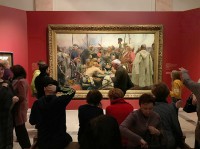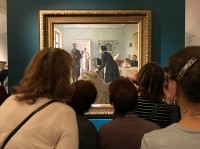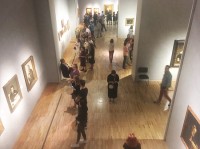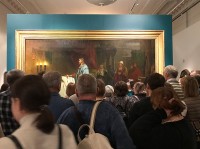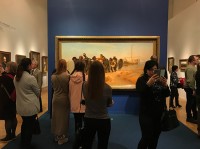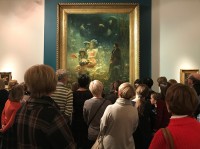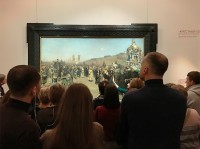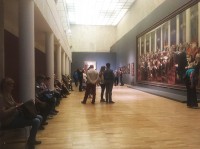The browser will either open the file, download it, or display a dialog.
Ilya Repin: The 175th Anniversary of the Artist’s Birth
March 16, 2019–August 18, 2019
The New Tretyakov Gallery, Moscow
October 3, 2019–March 9, 2020
The State Russian Museum, St. Petersburg
Catalogues:
Tatiana Karpova and Tatiana Yudenkova, eds.,
Ilya Repin. 1844–1930. Katalog vystavki.
Moscow: State Tretyakov Gallery, 2019.
592 pp.; 503 color illus.; index; selected bibliography.
Available in Russian with a brief summary and full list of exhibited works in English.
£40
ISBN 978–5–89580–260–1
Ilya Efimovich Repin. 1844–1930. K 175-letiiu so dnia rozhdeniia. Katalog vystavki.
St. Petersburg, State Russian Museum: Palace Editions, 2019.
320 pp.; 461 color illus.; no index; no bibliography.
Available in Russian and English.
Although late nineteenth-century realist painter Ilya Repin (1844–1930) has always been a household name in Russia, his prolific artistic legacy has remained largely unknown in the West, at least until recently. In light of the latest retrospective of the artist, it is useful then to recall that one of the earliest introductions of Repin to western scholarship resulted from his first large-scale retrospective in the USSR in 1936. I am talking about American art critic Clement Greenberg’s theoretical turned-highly influential essay “Avant-Garde and Kitsch,” published in the 1939 fall issue of Partisan Review.[1] Here Repin became one of the principal anti-heroes and embodiment of “academic kitsch” in Greenberg’s fight for the modernist cause. The critic later acknowledged that he mistakenly attributed a “battle scene” he discussed in the essay to Repin (the essay was not illustrated). Remarkably enough, the only painting in Repin’s legacy that has “battle” connotations, The Zaparozhye Cossacks Writing a Mocking Letter to the Turkish Sultan (1891; fig. 1), is a pretty good example of pre-digested art that “tells a story.” But this sole instance of “academic kitsch” surely does not exhaust Repin’s enormous and highly versatile artistic practice, which spanned nearly seven decades. Since the end of the Cold War, major English-language monographs on the artist have offered a more balanced and informed picture. These include Elizabeth Valkenier’s pioneering Ilya Repin and the World of Russian Art (1990) and the most recent and comprehensive account by David Jackson The Russian Vision: the Art of Ilya Repin (2006; 2014).[2] Despite Greenberg’s apparent lack of familiarity with Repin’s art, his reasons for choosing Repin as an example are still revealing. Greenberg was in part responding to United States film critic Dwight Macdonald’s essay “Soviet Society and Its Cinema,” published in the winter issue of the same journal. To parallel the decline of experimental Soviet cinema, Macdonald contrasted the enormous success of Repin’s major retrospective at the Tretyakov Gallery in 1936 to the empty halls of the Museum of Modern Western Art. He wrote: “Why, after all, should ignorant peasants prefer Repin to Picasso, whose abstract technique is at least as relevant to their own primitive folk art as is the former’s realistic style?”[3] Macdonald believed that this preference was conditioned by the totalitarian state. In response Greenberg argued that love of kitsch is natural and observable in any modern society, and that a totalitarian state exploits this potential rather than conditions it. Although “kitsch” proved to be too strong and largely misleading of a term, the polemics on the occasion of Repin’s first major retrospective—why an average person would prefer realistic art to modernist, abstract experiments?—are still legitimate and inviting, especially if one considers the exceptionally long queues of visitors to Repin’s shows in Russia last year.
Featuring approximately 170 paintings and 130 works on paper, the 2019 retrospective marked the 175th anniversary of the artist’s birth. The exhibition was open in Moscow for nearly six months, before moving to St. Petersburg’s State Russian Museum. The Tretyakov Gallery created a spectacular blockbuster event out of the exhibition, promoting it widely and in an engaging manner. One of the highlights was the video trailer, which re-enacted the plot of Repin’s well-known controversial painting They Did Not Expect Him (1884; fig. 2). In terms of marketing and public relations, the Tretyakov’s campaign reflected the ongoing rebranding and modernization of the museum, which was launched by its new energetic director Zelfira Tregulova several years ago. The Russian Museum’s promotional approach, on the other hand, was traditional and almost invisible in the city, although this did not affect the exhibition’s attendance—in St. Petersburg the halls were continuously as overcrowded as they were in Moscow (fig. 3). This seems to point to a major challenge of exhibiting Repin in Russia: when his brand is so big and recognizable, does a museum need to be inventive and scholarly to successfully sell his show?
Another challenge is the fact that Repin is fairly well-represented in Russian public museums. All key works that made Repin the leading artist of the period are on permanent display in the very two museums that hosted the 2019 retrospectives. The Russian Museum’s permanent galleries normally display many of the major works of Repin’s “academic” period, including his award-winning graduation piece Christ Raising Jairus’s Daughter from the Dead (1871; fig. 4), his most recognizable canvas Barge Haulers on the Volga (1873; fig. 5), and Sadko (1876; fig. 6), which Repin painted while studying abroad in Paris and for which he received the title of Academician. Meanwhile, the artist’s three most powerful and politically sensitive canvases—Religious Procession in the Province of Kursk (1883; fig. 7), They Did Not Expect Him, and Ivan the Terrible and His Son Ivan, November 16, 1581 (1885)—can usually be seen in the Tretyakov Gallery. (Ivan the Terrible was vandalized in May 2018, and as a result a number of preparatory studies were substituted for it.) The best examples of Repin’s state commissions—Emperor Alexander III Receives Village Elders in the Courtyard of the Petrovsky Palace in Moscow (1886) and the enormous Formal Session of the State Council, May 7, 1901, Marking the Centenary of its Foundation (1903; fig. 8)—are also featured in the permanent displays at the Tretyakov Gallery and the Russian Museum, respectively. In addition, both collections hold a representative assortment of portraits of social types and Russian intelligentsia, including writers, scientists, and fellow artists, along with high-ranking officials, nobility, and members of the imperial family. To put all these works together alone would expose and problematize what seems to me the two most important and understudied transformations in Repin’s very long and controversial career: namely, the way in which his conservative academic training enabled Repin to make the most powerful realist statements, and then, in turn, the way in which he, a leading protesting Russian realist artist, became a painter of the political establishment. Yet despite this opportunity, the exhibitions simply glossed over this fascinating conundrum.
Instead, the exhibitions represented Repin’s legacy in a rather expansive and generous manner. The core “academic,” “politically-sensitive,” and “government-sponsored” periods were interrupted by, interspersed with, and submerged in many other stories about the artist’s practice. Among these are Repin’s pre-Academy works, his Parisian trips, the Russian peasant series, Cossacks and ethnic types from trips to his homeland Ukraine, the “Norodniki” period, Abramtsevo, Zdrawneva, “Repin and Stasov,” “Repin and Tolstoy,” and the like. The 2019 retrospective also included the so-called “Penaty” period, which was focused around his works produced at a mansion in Kuokkala (now Repino) in Finland, where Repin lived and worked from 1903 onwards. After Finland gained independence in 1917, the artist did not relocate to Soviet Russia, preferring to remain in forced emigration. This late period is reasonably considered as his most problematic, both in terms of coherence and quality. Works such as What an Expanse! (1903) or 17 October 1905 (1907) simply look outlandish in light of Repin’s career and in the context of modernist developments of the time. Nevertheless, stuffed with a great number of superb drawings, preparatory sketches, and oil studies, which provide insight into familiar masterpieces, the 2019 retrospectives altogether extended and enriched, as much as distorted, Repin’s artistic identity already present in the museum’s permanent galleries.
It would be absolutely fine to compose such a survey were it not already the fourth large retrospective of Repin organized by the same institutions following the same schema. Indeed, perhaps no other Russian artist has been commemorated so regularly throughout the twentieth century, beginning with the first exhibition in 1924, on occasion of the artist’s eightieth birthday. The 1936 All-Soviet touring retrospective, with around nine hundred works, was apparently the largest ever. The Khrushchev Thaw witnessed another major survey in 1957–58, which included for the first time works from foreign collections, including the Helsinki Ateneum and the National Museum in Prague. Then followed the post-Soviet retrospective in 1994, which marked the 150th anniversary of the artist’s birth and included the brilliant portrait of Vsevolod Garshin from the Metropolitan Museum of Art. But all these and other add-ons never really altered the chronology-based narrative, which dully resembles every standard monograph on the artist.[4] It is thus hard to grasp any specific scholarly significance of the 2019 exhibitions, and one could easily feel a sense of déjà vu. The two richly illustrated catalogues—the stylish one by the Tretyakov Gallery and another by the Russian Museum—reinforce this notion. Repin’s anniversary exhibitions seem to have become a ritual rather than a scholarly opportunity.
What becomes more meaningful then is to consider the dramatically varying political contexts of this otherwise unadventurous chain of retrospectives. Thus, the touring 1936 exhibition was not intended to mark any anniversary but to facilitate the Soviet totalitarian state’s indoctrination of the socialist realist aesthetic, a campaign first officially pronounced in 1932. By this time, the already dead Repin was lauded as the precursor of socialist realism, and younger generations of artists were encouraged to emulate him and learn how academic skills can be employed in the service of socialist commitments. The Tretyakov and Russian Museum’s catalogues were pretty straightforward about this matter: Repin “is still very poorly studied by our young artists” and an exhibition “allows to trace the development of Repin’s creativity and determine its significance for Socialist art” (the Tretyakov Gallery); and “if we are to ask whom Soviet artists should learn from, along with other great masters we would say Ilya Repin” (the Russian Museum).[5] The 1994 retrospective took place in the wake of the de-sovietization of the country and the revaluation, if not romanticization, of the pre-revolutionary period, which seemed to valorize Repin’s imperial commissions. This exhibition represented this period more generously, featuring for the first time the artist’s paintings Wedding of Nicholas II and Alexandra Feodorovna (1894), Portrait of Nicholas II (1896), as well as the final version of Emperor Alexander III Receives Village Elders. And it is the current context of the 175th anniversary that perhaps most strikingly resonates with the polemics of Repin’s most politically-sensitive yet artistically persuasive period.[6] One may recall the famous Pussy Riot’s activist performance “Mother of God, Drive Putin Away” (2012) that criticized the corrupt alliance between the Orthodox Church and the government—just like Repin’s Religious Procession did in his own time, and which too provoked a public outcry. The subject of Repin’s They Did Not Expect Him likewise brought into public domain the suppressed topic of political prisoners, while his supposed history canvas Ivan the Terrible warned of the dangers of escalating political violence in the country. That is to say, the political context of the 2019 retrospective could also have offered an excellent opportunity to articulate the relevance of the most powerful period of Repin’s art today—if only the curators had more courage to go beyond the ritual.
Andrey Shabanov
Research Fellow and Lecturer
History of Art Department, European University at St. Petersburg
aswhite[at]eu.spb.ru
[1] Clement Greenberg, “Avant-Garde and Kitsch,” Partisan Review VI, no. 5 (Fall 1939): 34–49.
[2] Respectively, Elizabeth Valkenier, Ilya Repin and the World of Russian Art (New York: Columbia University Press, 1990) and David Jackson, The Russian Vision: The Art of Ilya Repin (Schoten: BAI, 2006).
[3] Dwight Macdonald, “Soviet Society and Its Cinema,” Partisan Review VI, no. 2 (Winter 1939): 88.
[4] Remarkably, the only exception to these clone-like exhibitions is the very first retrospective of Repin’s work shown at the Academy of Arts in 1891. Organized by the artist himself, it exhibited never before seen finished and preparatory works, such as studies, drawings, and sketches, which was innovative at the time.
[5] Respectively: I. E. Repin. Katalog vystavkli (Moscow: OGIZ–IZOGIZ, 1936), v; Katalog vystavki proizvedenii I. E. Repina (Leningrad: State Russian Museum, 1937), 6.
[6] See the most recent account on this subject: Andrey Shabanov, Art and Commerce in Late Imperial Russia: The Peredvizhniki, a Partnership of Artists (New York; London: Bloomsbury Academics, 2019), reviewed in the autumn 2019 issue of Nineteenth-Century Art Worldwide.


